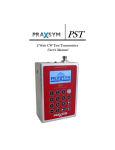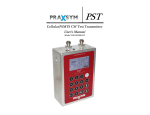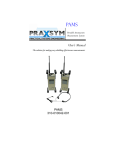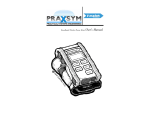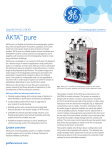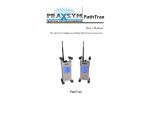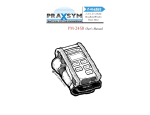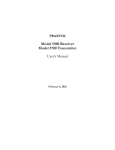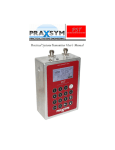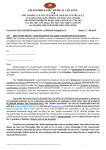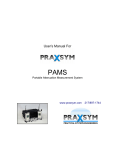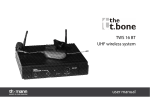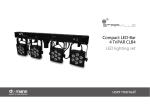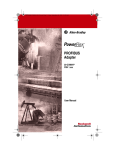Download PAMS-C Manual 900-000008-002 rev E
Transcript
PAMS - C Portable Attenuation Measurement System User’s Manual The commercial solution for making easy shielding effectiveness measurements PAMS - C 310-010042-003 PAMS-C TABLE OF CONTENTS Chapter 1 General Information • • • • Introduction Equipment Purpose Equipment List Specifications Chapter 2 System Care • • • 1 4 Transportation Recharging Safety/Handling Chapter 3 Operation 5 Describes operational sequences required for proper use of the product • Receiver • Transmitter • Making Shield Level Measurements • Audio Threshold/Tone Usage • Logging Measurement Data Chapter 4 Serial Interface • • • 13 Remote Operation Communications Interface Installing USB Serial Drivers Warranty Statement PRAXSYM warrants that all items will be free from defects in material and workmanship under use as specified in this guide for a period of one year from date of delivery. PRAXSYM further agrees to repair or replace, at its discretion, any failure which upon PRAXSYM's inspection appears to be a result of workmanship or material defect. In no case, shall PRAXSYM's liability for breach of warranty exceed the purchase price of the items in question. PRAXSYM's liability on any claim of any kind, for any loss connected with, or resulting from the use of, performance or breach thereof, installation, inspection, operation or use of any equipment furnished by PRAXSYM, shall in no case exceed the purchase price of the goods which give rise to the claim. PRAXSYM Chapter 1 General Information Introduction The Portable Attenuation Measurement System (PAMS) is designed to measure the shielding effectiveness of RF enclosures. PAMS-C is a variation of the original PAMS, having subtle differences to enhance usefulness in more commercialized settings. This product has been specifically engineered to enable regular maintenance of RF Shielded Enclosures. Routine measurements can be made to ensure a baseline shield level is maintained with minimal disruption to normal activities of the enclosure. Equipment Purpose The PAMS-C measures the shielding effectiveness of RF enclosures, displaying results in both bar graph and numeric readout of the shielding level (dB). Separately, the transmitter and receiver will also work well in custom applications. The transmitter provides a portable and semi-rugged CW transmitter with adjustable output power up to 1 Watt in the frequency range from 864 MHz to 936 MHz. The receiver’s features allow it to make accurate signal level measurements as low as -120 dBm in the presence of high ambient wireless energy, over a large dynamic range. The receiver measures the signal level of CW and narrowband signals applied to the 50 Ω BNC input port located on the top of the receiver. The gain or loss of an antenna or coax cable connected to the RF input will need to be added to the value displayed on the screen. Equipment List • • • • • • • • Transmitter Receiver Rechargeable Battery Packs (2 each, one installed per unit) AC/DC power supply with cord, 15 VDC @ 3.4A (2 each) 32 Ω headphone set Antennas (2 each), extended 1/4 wavelength Transit Case User’s Manual Page 1 PAMS-C PAMS-C Receiver Specifications Frequency 864-936 MHz Channel Spacing 100 kHz Detection Mode CW Measurement Range -120 to 0 dBm Measurement Accuracy +/-2 dB (-110 to 0 dBm) Frequency Stability +/- 2.5 ppm Charge Voltage at Power Jack DC, 15 V, +/-1.0 V Battery Operation 4 hours operation 70 minutes charge Controls OFF/VOL, MODE, CAL, FREQ, TUNE, T’HOLD UP/ DOWN, LOCK, LIGHT Indicators BATTERY LEVEL, SIGNAL LEVEL, THRESHOLD SETTING, MODE, LOCK, CAL STATUS, FREQ, FREQ ADJ User Interface Full Alpha-numeric Back lit LCD display Operating Temperature 0°C to 40°C Weight 5.5 lbs. Size 11.7” H x 5.1” D x 4.9” W Headphone Impedance 32 Ω Page 2 PRAXSYM PAMS-C Transmitter Specifications Frequency 864-936 MHz Channel Spacing 100 kHz Output Power -30 dBm to +30 dBm Attenuation 0 to 60 dBm 1, 2 or 5 dB steps Frequency Stability +/-2.5 ppm Charge Voltage at Power Jack DC, 15 V, +/-1.0 V Battery Operation 2 hours operation 70 minutes charge Controls OFF/ON, MODE, ATTEN FREQ, TUNE, LOCK, LIGHT Indicators BATTERY LEVEL, OUTPUT POWER, MODE, LOCK, ATTEN LEVEL, FREQ User Interface Full Alpha-numeric Back lit LCD display Operating Temperature 0°C to 40°C Weight 5.5 lbs. Size 11.7” H x 5.1” D x 4.9” W Page 3 PAMS-C Chapter 2 System Care Transportation The PAMS-C is normally shipped (and transported) in a shock resistant transfer case. Batteries for the transmitter and receiver are contained inside the respective units. Recharging the PAMS-C Units To charge the battery pack inside the PAMS-C unit, plug the 2.5mm female connector of the AC/DC 15 V power pack into the power receptacle on the right side of the PAMS-C Transmitter or Receiver. Plug the charger line cord into an AC source (95-250 VAC, 47-63 Hz). The green CHARGE light on the front face of the PAMS-C unit should illuminate during the entire fast charge cycle. The fast charge cycle of a discharged battery will normally take less than 1.5 hours. When the unit is fully charged, the CHARGE light will begin flashing indicating the trickle charge phase. The trickle charger will continue to top-off the battery pack until the AC/DC power pack is disconnected. Although this top-off process is normally completed in less than 6 hours, it can be left on overnight. The battery may self-discharge to less than 3 Volts after a period of storage or if the unit is left on for several days. During a new charge cycle it will first enter a pre-charge trickle state before beginning the fast charge phase. The green CHARGE light will flash during this phase and then stay on continually once the fast charge phase has begun. The pre-charge trickle phase can take anywhere form a few seconds to 60 minutes dependent on the initial charge state. If the fast charge state has not begun after several hours, the battery pack should be replaced. If a charge cycle is initiated on a fully charged battery, it is possible that it will not be able to complete a normal charging cycle, illuminating the FAULT light. Although the FAULT light indicates that the charge cycle was terminated, the trickle charge will continue to top-off the battery pack and it does not indicate a failure. The FAULT light indicates that the charge process has been terminated. A FAULT light will be indicated with: 1. Excess supply input voltage 2. Very low battery voltage (indicate shorted cells) 3. Battery voltage low after 1/12th of charge timer 4. The charge is not normally terminated before the end of the cycle timer Page 4 PRAXSYM The OVERTEMP light indicates that the battery pack has exceeded its maximum temperature during the charge process. When the OVERTEMP light is lit, the CHARGE light will be turned off indicating that the charge process has been halted. Once the battery has cooled down to an acceptable temperature, the charge cycle will resume. If it becomes necessary to remove or replace the NiCad battery pack: • Locate the bottom face plate of the unit, which houses the battery • • • • compartment cover Remove 4 socket head screws from the battery cover bumper Remove 4 Phillips head screws from the battery cover Remove the battery cover and disconnect the 2 pin connector Slide the battery out of the compartment Storing the PAMS-C Units If the PAMS-C units will be stored for long periods between use (2-3 months), it is a good practice to disconnect the batteries to ensure long battery life. With the batteries disconnected, they can be stored charged or discharged. To disconnect the batteries, unplug the 2 pin connector using the process described in the proceeding paragraph. Safety/Handling The PAMS-C system has been designed to survive in-field usage, however the following handling restrictions should be observed: • Protect the units from electrostatic discharge • Do not connect high power RF sources (>100 mW) to the input BNC connector on the receiver. Always use a 30 dB in-line attenuator when connecting the transmitter directly to the receiver input. • Do not connect DC sources to the BNC connectors • The Receiver’s RF Input contains a DC bias voltage on the BNC center pin for powering an external RF switch. Always use a DC block when connecting the receiver to test equipment. Equipment Service Praxsym, Inc. provides repair and maintenance service. Ph 217.897.1744 www.praxsym.com [email protected] Chapter 3 Operation Receiver Modes The receiver can be operated in one of four different modes: Signal Strength, Spectrum Monitor, Shield Level, and Data Logging. Page 5 PAMS-C In SIGNAL STRENGTH mode the receiver can be used to measure the signal level of a continuous wave signal. The receiver has a narrow (+/-7.5 kHz) IF bandwidth enabling it to measure a test signal in the presence of interfering signals in the same band. Although the receiver has no demodulation capabilities, it can be used to measure the signal level of narrow band modulated signals. In SPECTRUM MONITOR mode the receiver can be used to view a 12 MHz span of the frequency spectrum. This mode is ideal for locating a clear frequency for conducting a test by identifying large interfering signals that could cause measurement errors. In SHIELD LEVEL mode the receiver can be used to measure the amount of attenuation/ shield level that is provided by an enclosure or other obstacles between the transmitter and receiver. Before a shield level test is conducted, the receiver is initialized with the transmitter to read 0 dB shield level. In DATA LOGGING mode, the receiver can be used to make measurements and store them in a list that is saved when the receiver is turned off. The receiver will store data as signal strength (dBm) or shield level (dB). See the section on Data Logging for more information. Page 6 PRAXSYM Initial Set-Up and Power On • • • • Attach one of the antennas to the BNC connector located on the top of the receiver. Power-On/Rotate POWER switch to ON position. The receiver will power on in SIGNAL STRENGTH mode. To select a different mode, depress the MODE switch to rotate through SIGNAL STRENGTH, SPECTRUM MONITOR, SHIELD LEVEL and DATA LOGGING modes. Allow the receiver to warm up for 5 minutes before taking measurement data. Set Frequency • • • • • The receiver always powers up tuned to 900 MHz. Rotate the FREQUENCY adjust knob to tune the receiver in steps of 1 MHz. Depress the F.DIGIT switch to toggle the step size between 1 MHz and 100 kHz. The current step size is displayed on the FR ADJ line of the display. The frequency can be set in either SIGNAL STRENGTH or SHIELD LEVEL mode. The receiver will remain tuned to this frequency as it is rotated through it’s four modes of operation. In SPECTRUM MONITOR mode, this frequency will become the center frequency of the 12 MHz frequency span. Using the THOLD arrow keys in SPECTRUM MONITOR mode to move to a different part of the spectrum will not effect the receiver frequency when changing modes. The SPECTRUM MONITOR screen displays 12 MHz of signals at a time from 864-936 MHz. Along the bottom of the screen the start, center, and stop frequencies are displayed. The FREQUENCY select knob is used to move the marker across the spectrum. The marker’s frequency and the measured signal level at that frequency are displayed at the top of the display screen. The THOLD arrows scroll through the 12 MHz spans of the receivers frequency range. Setting the Tone Threshold The receiver contains a tone generator that can be used to alert the operator if shield level has dropped below a predetermined threshold level. This feature is especially useful when sweeping across seams or around openings in a shielded enclosure when the LCD display is not easy to view. Page 7 PAMS-C The tone alert feature may only be used in SHIELD LEVEL mode. The frequency of the output tone is determined by the signal level measured by the receiver. • Using the THOLD arrow keys on the top of the receiver, adjust the threshold level to the desired level that the tone will be turned on. The threshold level is displayed on the LCD on the THOLD line. In SHIELD LEVEL mode, this is the point where the shield level has degraded to the point that the operator should be alerted by the tone. • Connect the 32 Ω headset to the PHONES jack on the top of the receiver. • The receiver’s ON/OFF switch is also the volume control for the tone generator output. The tone threshold function will operate normally when collecting shield level data in the Data Logging mode. Initializing Shield Level Measurements In SHIELD LEVEL mode the signal level measured by the receiver must be initialized to the test signal from the transmitter to indicated 0 dB shield level when the enclosure is open. This initialization process is completed by depressing the CAL button. Details of the initialization process are detailed in the Making Shield Level Measurements section. Backlight Depress the LIGHT button on the top of the receiver to toggle the LCD backlight on/off. Leaving the backlight on continuously will decrease the battery operating time by approximately 10%. Control Lock Once set, the controls of the receiver can be locked to prevent inadvertently changing a setting that could result in measurement errors. Depress the LOCK button on the top of the receiver to toggle the lock feature on/off. Transmitter The transmitter is a continuous wave signal source with adjustable output transmit level over it’s frequency range. Initial Set-Up and Power On • Attach one of the antennas to the BNC connector located on the top face of the transmitter. Page 8 PRAXSYM • • Power On / rotate POWER switch to ON position. Allow a 5 minute warm-up period before making measurements. Set the Output Level The transmitter powers up with the output level set to -30 dBm (60 dB attenuation). The output level of the transmitter is adjusted by changing the attenuation level. -30 dBm output level corresponds to 60 dB attenuation and +30 dBm (1 watt) corresponds to 0 dB attenuation. The output level can be changed using either the ATTEN button or the FREQUENCY control knob. • Depress the ATTN button on the top of the transmitter to toggle between 0 dB and 60 dB of attenuation. • Depress the MODE button on the top of the transmitter to toggle the function of the FREQUENCY control knob between frequency adjust mode and power adjust mode, allowing adjustment of the attenuator in smaller steps. The current setting of the mode button is displayed on the LCD. • Depress the F. DIGIT button on the top of the transmitter to rotate the increment of the FREQUENCY select knob between 1, 2 and 5 dB steps. Set Frequency • • • • The transmitter always powers up tuned to 900 MHz. Depress the MODE button on the top of the transmitter to toggle the function of the FREQUENCY control knob between frequency adjust mode and power adjust mode. The current setting of the mode button is displayed on the LCD. Rotate the FREQUENCY adjust knob to tune the transmitter in 1 MHz steps. Depress the F.DIGIT switch to toggle the step size between 1 MHz and 100 kHz. The current step size is displayed on the FR ADJ line of the display. Making Shield Level Measurements • The receiver measures the signal level of CW and narrowband signals applied to the 50 Ω BNC input port located on the top of the receiver. The gain or loss of an antenna or coax cable connected to the RF input will need be added to the value displayed on the screen. Page 9 PAMS-C • • • Before making shield level measurements, turn on the transmitter and receiver, tune both units to the test frequency, set the output of the transmitter to 60 dB attenuation, allow both units to warm up for 5 minutes. With the receiver in SIGNAL STRENGTH mode, monitor the test frequency to insure no interfering signal is present on your test frequency. When making measurements in an unfamiliar area, set the receiver to SPECTRUM MONITOR mode to determine frequencies in the spectrum that are clear to use for testing your shielded enclosure. The 60 dB shielding level indication offsets the 60 dB output attenuation on the transmitter. By placing the transmitter and receiver 4-5 feet apart, approximately 30 dB of free space path loss exists. When calibrating the units, the receiver has been designed to account for this amount of path loss in conjunction with the 60 dB of attenuation given by the transmitter. Thus, when the attenuation is removed from the transmitter, the receiver will read very close to 0dB shield level. • With the transmitter and receiver both set to the same test fre- • quency, place the transmitter inside the enclosure on a marked reference position near the center of the enclosure. Ensure the transmitter output level is set to -30 dB. Place the receiver outside the enclosure on a marked reference position, at least four feet from the transmitter. Ensure that the receiver reference position is within line of sight of the transmitter. Page 10 PRAXSYM • • • • • • Set the receiver to SHIELD LEVEL mode, the receiver will flash “INITIALIZE? PRESS CAL” on the display. Ensure that there are no obstructions between the transmitter and receiver and then depress the CAL button on the Receiver. The display should indicate a SHIELD LEVEL of 60 dB. Return to the transmitter and depress the ATTN button. The attenuation will toggle to 0 dB and the transmitter is now at +30 dBm output. Verify that the SHIELD LEVEL reads less than 3 dB on the receiver. This may vary slightly as every environment is unique. A reading of 0 dB is ideal. Close the door to the enclosure and begin sniffing with the Receiver. The Receiver is now measuring and displaying SHIELD LEVEL of the enclosure. Audio Threshold/Tone Usage • • Depress the ←/→ THRESHOLD switches until the desired threshold is set. Plug a set of 32 Ω headphones in the jack on the top face of the unit. If the shielding level is less than the threshold, a variable tone is emitted. Low frequency tones correspond to low (poor) shielding levels, while high frequency tones signify high (better) shielding levels. Page 11 PAMS-C • • If the shielding level exceeds the threshold, no tone sounds. Depress the lock switch to toggle the control lock function. With the control lock enabled, the operator is protected against accidental control inputs invalidating a test. Logging Measurement Data • • • • • To enter data logging mode, depress the ←/→ THRESHOLD switches to select signal strength data or shield level data. Press the CAL button to begin. Pressing the LOCK button to lock out the MODE button during the data logging process prevents the user from inadvertently exiting the data logging mode while taking data. The flashing cursor located to the left of the data entry points indicates the location where the measured data will be logged. To record measured data into the data entry point depress the CAL button. The next data point may be selected by depress the ←/→ THRESHOLD switches to select the data entry point to log. Data entry points may be over written, or skipped. Use the MODE button to save the logged data and exit data logging mode. Unsaved data will be lost when the Receiver is powered down. Before shield level data can be logged, the receiver and transmitter must first be setup and initialized as described in the Making Shield Level Measurements section. The receiver stores up to 100 data samples as signal strength (dBm) or shield level (dB) which may be downloaded to a PC. The screen displays 10 data entry points at a time. The flashing cursor located to the left of the data entry points indicates the location where the measured data will be logged. The second line of the screen shows the current frequency and the measured signal strength in real time. The transmitter and receiver must be set to the same frequency for data to be valid. Page 12 PRAXSYM Chapter 4 Serial Interface Remote Operation Both the transmitter and receiver can be controlled by a PC or embedded controller via the USB interface. Procedures in this section describe how to control the PAMS-C units remotely with terminal emulation software on a PC or laptop computer. Configuring Tera Term Pro Install a cable between a USB port on the PC/laptop and the USB port on the PAMS-C unit. The supplied cable has a USB A plug (connects to PC) on one end and a Mini-USB 5-pin (type B) plug on the opposite end (Praxsym part # 520-010004-002). Power up the PAMS-C unit by rotating the ‘ON/OFF’ knob. Start the terminal emulation software and open the Terminal setup window from the Setup Menu. Select CR+LF for Receive and CR for Transmit. Enable Local Echo. Also within the Setup menu, choose the Serial Port options listed below. Baud rate Data bits Stop bits Parity Com port 9600 8 1 none assigned by PC operating system If you are using another terminal emulation program, the settings may be found in various places depending on the software used. Generally, check the Serial Port and Terminal configuration menus. NOTE: Tera Term must be closed and the USB cable removed before manually powering down the PAMS-C unit. Page 13 PAMS-C Commands Commands may be sent to the PAMS-C transmitter or receiver to set up the operation of the unit (SET commands) or to determine the setup and request data (QUERY commands). Entries may be in either lower or upper case. <CR> represents ‘ENTER.’ The response to successfully executed SET commands is the message OK <CR>. RECEIVER COMMANDS LC<CR> Clears the data log LR<CR> The entire data log is read. The data is distributed in a 10 x 10 table read left to right. The first position in the second row is data log entry number 11. FR=XXX.y<CR> Sets the receive frequency (in MHz). The inclusion of the decimal point and digits to the right of the decimal are optional. FR?<CR> Returns the current frequency setting in the form XXX.y (MHz). Example: 915.4 SS?<CR> Returns the last measured signal strength in the form (-)XXX (dBm). Example: -70 SL?<CR> Returns the last measured shield level in the form XXX (dB). Example: 112 BA?<CR> Returns the current battery voltage in volts. Example: BA=09.30 VR?<CR> Returns the version of firmware installed. Example: PAMS-C Receiver version 1.xx Page 14 PRAXSYM TRANSMITTER COMMANDS FR=XXX.y<CR> Sets the output frequency (in MHz). The inclusion of the decimal point and digits to the right of the decimal are optional. FR?<CR> Returns the current frequency setting in the form XXX.y (MHz). Example: 915.4 AT=XX<CR> Sets the output attenuator. Valid levels for XX are 00 to 60 (dB). Example: AT=30 (sets the output attenuator to 30 dB for an output level of 0 dBm. AT?<CR> Returns the current setting of the output attenuator. Example: AT=30 PO=(-)XX<CR> Sets the transmitter output level. Valid levels for XX are -30 to 30 (dBm). Example: PO=30 (sets the output level to 30 dBm, attenuator = 0 dB) PO?<CR> Returns the output level of the transmitter in dBm. Example: PO=+30 (output level is +30 dBm) SR?<CR> Status Request returns the status of the transmitter. Example: LC, OK “LC” local mode “RM” remote mode “OK” normal operation “UNLCK” synthesizer is unlocked RM<CR> Places the transmitter controls in remote mode, locking control until the transmitter receives an LC command or the power is cycled. LC<CR> Places the transmitter controls in local mode. Page 15 PAMS-C TRANSMITTER COMMANDS CONTINUED BA?<CR> Returns the current battery voltage in volts. Example: BA=09.30 TMP?<CR> Returns the temperature of the transmitter in degrees C. Example: TMP=+032C VR?<CR> Returns the version of firmware installed. Example: PAMS TX v1.xx mm-dd-yyyy Error Responses Invalid commands will be acknowledged with an error response. An error response will consist of 4 ASCII bytes followed by a carriage return. The error code consists of the two characters ER followed by a two-character error status code. ERIC<CR> Invalid command The command was not recognized because it was not in the proper format. ERIN<CR> Invalid number or range The data included in the previous command was invalid or out-of-range. ERIM<CR> Invalid command for current mode of operation The command was not recognized because it was not valid for the current mode of operation. ERNI<CR> System not initialized (receiver only) Response to the “SL?” query when the receiver has not been initialized with the transmitter. Page 16 PRAXSYM Installing the USB-Serial Drivers Plug the PAMS-C unit into an available USB port using the supplied cable. Begin installation of the USB Serial Converter Click ‘Next” Insert supplied CD and continue with automatic software installation, decline the option to use Windows Update software search Page 17 PAMS-C The Wizard will find and begin installation of the software Page 18 PRAXSYM Click ‘Finish’ The USB Serial Converter is now installed Begin installation of the USB Serial Port Decline the option to use Windows Update software search Click ‘Next” Page 19 PAMS-C Continue with automatic software installation The Wizard will find and begin installation of the software Page 20 PRAXSYM Click ‘Finish’ The USB Serial Port is now installed Page 21 PRAXSYM 010611 Rev E 900-000008-002
























